inflation pressure Lexus LC500 2021 Owner's Manual / LEXUS 2021 LC500,LC500H OWNER'S MANUAL (OM11559U)
[x] Cancel search | Manufacturer: LEXUS, Model Year: 2021, Model line: LC500, Model: Lexus LC500 2021Pages: 448, PDF Size: 14.11 MB
Page 1 of 448

LC500_LC500h_OM_OM11559U_(U)
1
2
3
4
5
6
7
8
9
Pictorial indexSearch by illustration
For safety
and securityMake sure to read through them
(Main topics: Child seat, theft deterrent system)
Vehicle status
information and
indicatorsReading driving-related information
(Main topics: Meters, multi-information display)
Before drivingOpening and closing the doors and windows,
adjustment before driving
(Main topics: Keys, doors, seats)
DrivingOperations and advice which are necessary for driving
(Main topics: Starting engine
Interior featuresUsage of the interior features
(Main topics: Air conditioner, storage features)
Maintenance
and careCaring for your vehicle and maintenance procedures
(Main topics: Interior and exterior, light bulbs)
When trouble
arisesWhat to do in case of malfunction and emergency
(Main topics: Battery discharge, flat tire)
Vehicle
specificationsVehicle specifications, customizable features
(Main topics: Fuel, oil, tire inflation pressure)
For ownersReporting safety defects for U.S. owners, and seat belt,
SRS airbag and headlight aim instructions for Canadian
owners
IndexSearch by symptom
Search alphabetically
Page 4 of 448

4TABLE OF CONTENTS
6-2. MaintenanceMaintenance requirements ..... 295
General maintenance ................ 296
Emission inspection and mainte- nance (I/M) programs ............ 299
6-3. Do-it-yourself maintenance Do-it-yourself service precautions........................................................... 300
Hood.................................................. 302
Positioning a floor jack............... 302
Engine compartment.................. 304
12-volt battery.................................. 311
Tires .................................................... 313
Replacing the tire .......................... 321
Tire inflation pressure ................. 325
Wheels.............................................. 327
Air conditioning filter..................328
Electronic key battery ................ 330
Checking and replacing fuses . 331
Headlight aim................................. 335
Light bulbs ....................................... 336
7-1. Essential information Emergency flashers..................... 338
If your vehicle has to be stopped in an emergency ............................. 338
If the vehicle is trapped in rising water............................................... 339
7-2. Steps to take in an emergency If your vehicle needs to be towed............................................................ 341
If you think something is wrong ........................................................... 345Fuel pump shut off system
(LC500) ...................................... 346
If a warning light turns on or a warn- ing buzzer sounds..................... 347
If a warning messa ge is displayed
.......................................................... 356
If you have a flat tire .................... 362
If the engine will not start (LC500) .......................................................... 363
If the hybrid syst em will not start
(LC500h).................................... 364
If you lose your keys.................... 366
If the fuel filler door cannot be opened .......................................... 366
If the electronic key does not oper- ate properly ................................. 367
If the 12-volt battery is discharged .......................................................... 369
If your vehicle overheats (LC500) .......................................................... 376
If your vehicle overheats (LC500h) .......................................................... 379
If the vehicle becomes stuck ... 382
8-1. Specifications Maintenance data (fuel, oil level, etc.) ................................................. 386
Fuel information............................ 395
Tire information ............................ 397
8-2. Customization Customizable features .
.............405
8-3. Items to initialize Items to initialize ............................. 417
7When trouble arises8Vehicle specifications
Page 13 of 448
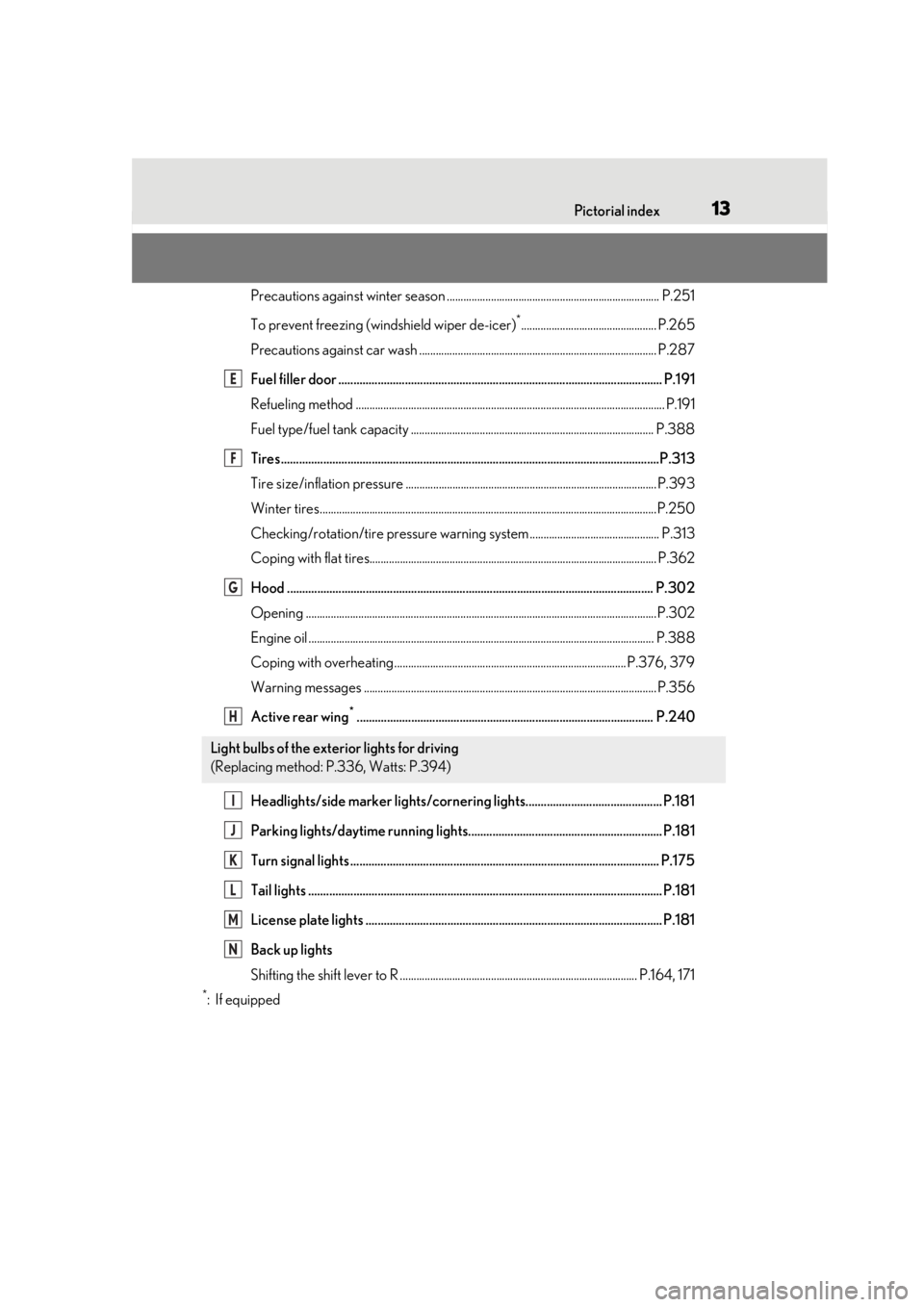
13Pictorial index
Precautions against winter season ............................................................................. P.251
To prevent freezing (windshield wiper de-icer)
*................................................. P.265
Precautions against car wash ............................. ......................................................... P.287
Fuel filler door ........................................................................................................... P.19 1
Refueling method ............................................................................................................... .P.191
Fuel type/fuel tank capacity ...... .................................................................................. P.388
Tires.......................................................................................................................... ...P.313
Tire size/inflation pressure ........................................................................................... P.393
Winter tires..........................................................................................................................P.250
Checking/rotation/tire pressure warning system............................................... P.313
Coping with flat tires........................................................................................................ P .362
Hood ......................................................................................................................... P. 302
Opening ........................................................................................................................ .......P.302
Engine oil ..................................................................................................................... ........ P.388
Coping with overheating .................................................................................... P.376, 379
Warning messages .......................................................................................................... P.356
Active rear wing
*.................................................................................................. P.240
Headlights/side marker lights/cornering lights............................................. P.181
Parking lights/daytime running lights................................................................ P.181
Turn signal lights ...................................................................................................... P.175
Tail lights .................................................................................................................... .P.181
License plate lights .................................................................................................. P.181
Back up lights
Shifting the shift lever to R .............................. ........................................................ P.164, 171
*:If equipped
Light bulbs of the exterior lights for driving
(Replacing method: P.336, Watts: P.394)
E
F
G
H
I
J
K
L
M
N
Page 206 of 448

2064-5. Using the driving support systems
• The vehicle is wobbling.
• The vehicle is being driven at extremely high speeds.
• When driving on a hill
• If the radar sensor or front camera is mis- aligned
●In some situations such as the following,
sufficient braking force may not be
obtained, preventing the system from
performing properly:
• If the braking functions cannot operate to
their full extent, such as when the brake
parts are extremely cold, extremely hot,
or wet
• If the vehicle is not properly maintained (brakes or tires are excessively worn,
improper tire inflation pressure, etc.)
• When the vehicle is being driven on a gravel road or other slippery surface
●Some pedestrians such as the following
may not be detected by the radar sensor
and front camera, preventing the system
from operating properly:
• Pedestrians shorter than approximately 3.2 ft. (1 m) or tall er than approximately
6.5 ft. (2 m)
• Pedestrians wearing oversized clothing (a rain coat, long skirt, etc.), making their
silhouette obscure
• Pedestrians who are carrying large bag- gage, holding an umbrella, etc., hiding
part of their body
• Pedestrians who are bending forward or squatting
• Pedestrians who are pushing a stroller, wheelchair, bicycle or other vehicle
• Groups of pedestrians which are close
together
• Pedestrians who are wearing white and look extremely bright
• Pedestrians in the dark, such as at night or while in a tunnel
• Pedestrians whose clothing appears to
be nearly the same co lor or brightness as
their surroundings
• Pedestrians near walls , fences, guardrails,
or large objects
• Pedestrians who are on a metal object (manhole cover, steel plate, etc.) on the
road
• Pedestrians who are walking fast
• Pedestrians who are changing speed abruptly • Pedestrians running out from behind a
vehicle or a large object
• Pedestrians who are extremely close to
the side of the vehicle (outside rear view
mirror, etc.)
■If VSC is disabled
●If VSC is disabled ( P.244), the pre-col-
lision brake assist and pre-collision brak-
ing functions are also disabled.
●The PCS warning light will turn on and
“VSC Turned Off Pre-Collision Brake
System Unavailable” will be displayed on
the multi-information display.
Page 247 of 448
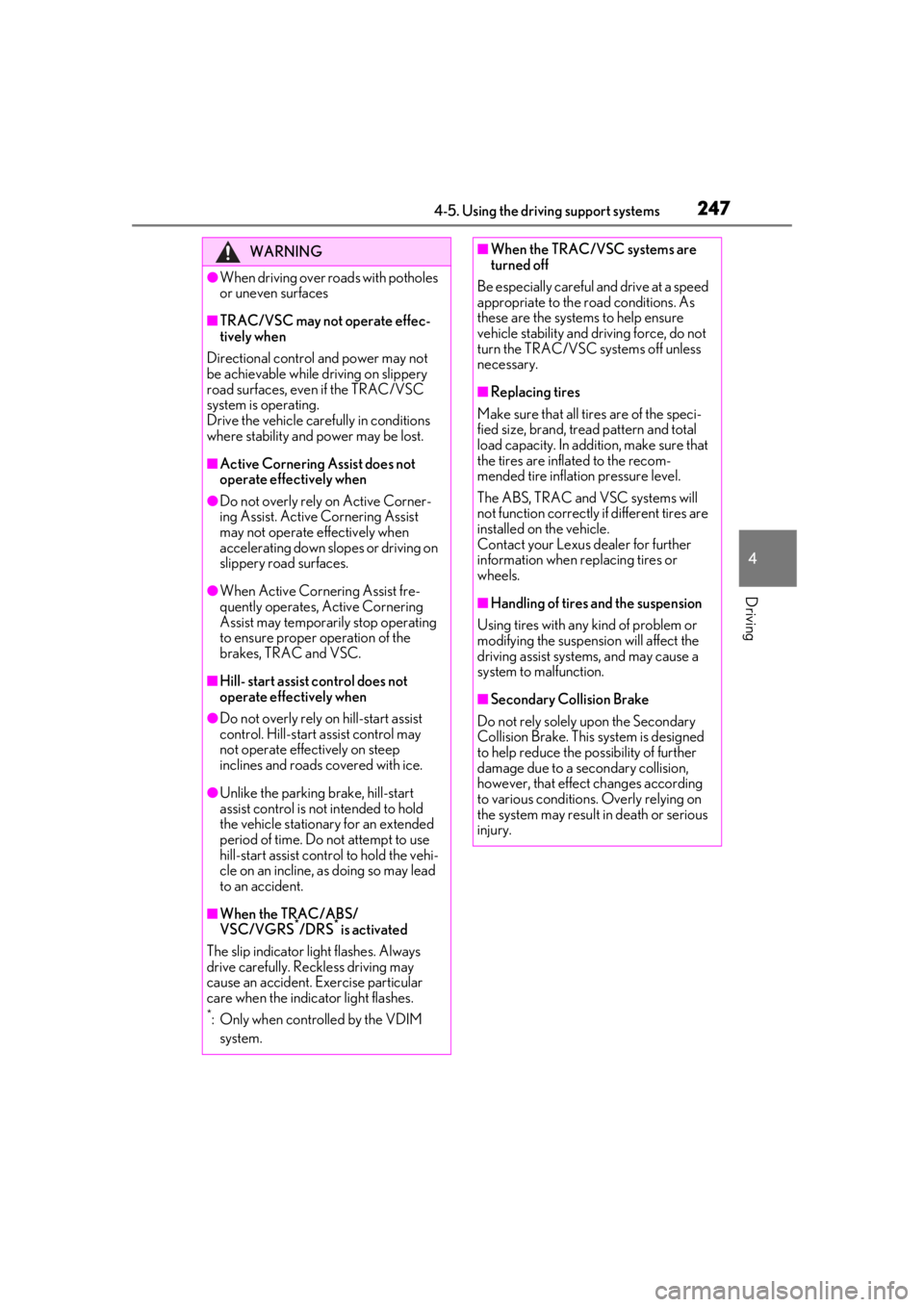
2474-5. Using the driving support systems
4
Driving
WARNING
●When driving over roads with potholes
or uneven surfaces
■TRAC/VSC may not operate effec-
tively when
Directional control and power may not
be achievable while driving on slippery
road surfaces, even if the TRAC/VSC
system is operating.
Drive the vehicle carefully in conditions
where stability and power may be lost.
■Active Cornering Assist does not
operate effectively when
●Do not overly rely on Active Corner-
ing Assist. Active Cornering Assist
may not operate effectively when
accelerating down slopes or driving on
slippery road surfaces.
●When Active Cornering Assist fre-
quently operates, Active Cornering
Assist may temporarily stop operating
to ensure proper operation of the
brakes, TRAC and VSC.
■Hill- start assist control does not
operate effectively when
●Do not overly rely on hill-start assist
control. Hill-start assist control may
not operate effectively on steep
inclines and roads covered with ice.
●Unlike the parking brake, hill-start
assist control is not intended to hold
the vehicle stationary for an extended
period of time. Do not attempt to use
hill-start assist control to hold the vehi-
cle on an incline, as doing so may lead
to an accident.
■When the TRAC/ABS/
VSC/VGRS*/DRS* is activated
The slip indicator light flashes. Always
drive carefully. Re ckless driving may
cause an accident. Exercise particular
care when the indicator light flashes.
*: Only when controlled by the VDIM
system.
■When the TRAC/VSC systems are
turned off
Be especially careful and drive at a speed
appropriate to the road conditions. As
these are the systems to help ensure
vehicle stability and driving force, do not
turn the TRAC/VSC systems off unless
necessary.
■Replacing tires
Make sure that all ti res are of the speci-
fied size, brand, tread pattern and total
load capacity. In addition, make sure that
the tires are inflated to the recom-
mended tire inflation pressure level.
The ABS, TRAC and VSC systems will
not function correctly if different tires are
installed on the vehicle.
Contact your Lexus dealer for further
information when replacing tires or
wheels.
■Handling of tires and the suspension
Using tires with any kind of problem or
modifying the suspensi on will affect the
driving assist systems, and may cause a
system to malfunction.
■Secondary Collision Brake
Do not rely solely upon the Secondary
Collision Brake. This system is designed
to help reduce the possibility of further
damage due to a secondary collision,
however, that effect changes according
to various conditions. Overly relying on
the system may result in death or serious
injury.
Page 249 of 448

2494-6. Driving tips
4
Driving
Control and maintain the vehicle at a
constant speed. Before stopping at a
toll booth or similar, allow plenty of
time to release the accelerator and
gently apply the brakes. A greater
amount of electrical energy can be
regenerated when slowing down.
Use the air conditioning only when
necessary. Doing so can help reduce
excessive gasoline consumption.
In summer: When the ambient tem-
perature is high, use the recirculated
air mode. Doing so will help to reduce
the burden on the air conditioning sys-
tem and reduce fuel consumption as
well.
In winter: Because the gasoline engine
will not automatically cut out until it and
the interior of the vehicle are warm, it
will consume fuel. Also, fuel consump-
tion can be improved by avoiding over-
use of the heater.
Make sure to check the tire inflation
pressure frequently. Improper tire infla-
tion pressure can cause poor fuel
economy.
Also, as snow tires can cause large
amounts of friction, their use on dry
roads can lead to poor fuel economy.
Use tires that are appropriate for the
season. Carrying heavy luggage will lead to
poor fuel economy. Avoid carrying
unnecessary luggage.
Installing a large
roof rack will also cause poor fuel
economy.
Since the gasoline engine starts up and
cuts out automatically when cold,
warming up the engine is unnecessary.
Moreover, frequently driving short dis-
tances will cause the engine to repeat-
edly warm up, which can lead to excess
fuel consumption.
Highway driving
Air conditioning
Checking tire inflation pressure
Luggage
Warming up before driving
Page 285 of 448

285
6
6
Maintenance and care
Maintenance and care
6-1. Maintenance and careCleaning and protecting the vehi-cle exterior ................................ 286
Cleaning and protecting the vehi- cle interior ................................. 289
6-2. Maintenance Maintenance requirements .. 295
General maintenance ............. 296
Emission inspection and mainte- nance (I/M) programs ......... 299
6-3. Do-it-yourself maintenance Do-it-yourself service precautions........................................................ 300
Hood............................................... 302
Positioning a floor jack............ 302
Engine compartment............... 304
12-volt battery............................... 311
Tires ................................................. 313
Replacing the tire ....................... 321
Tire inflation pressure .............. 325
Wheels........................................... 327
Air conditioning filter...............328
Electronic key battery ............. 330
Checking and replacing fuses ......................................................... 331
Headlight aim.............................. 335
Light bulbs .................................... 336
Page 298 of 448
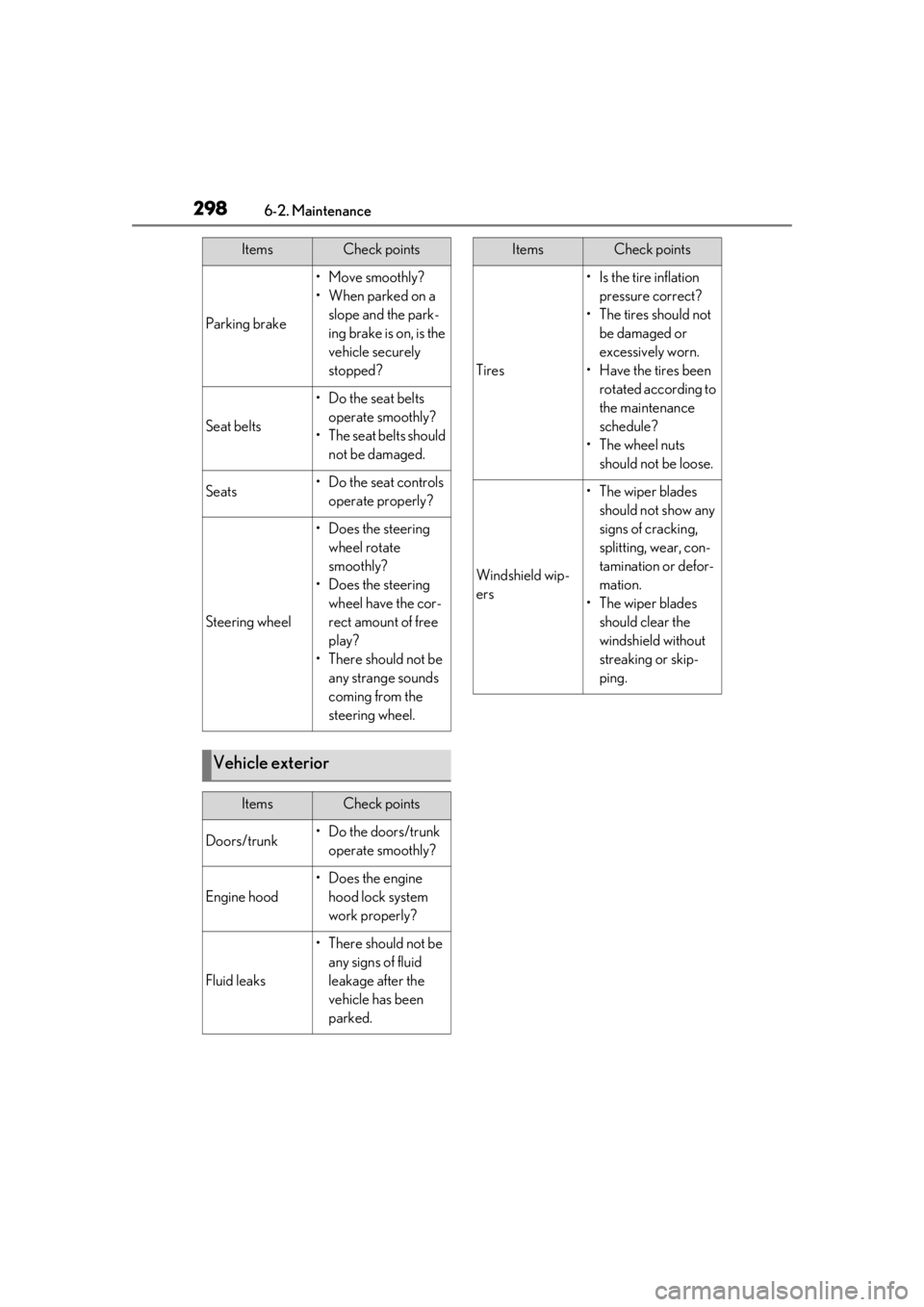
2986-2. Maintenance
Parking brake
• Move smoothly?
•When parked on a slope and the park-
ing brake is on, is the
vehicle securely
stopped?
Seat belts
• Do the seat belts operate smoothly?
• The seat belts should not be damaged.
Seats• Do the seat controls operate properly?
Steering wheel
• Does the steering wheel rotate
smoothly?
• Does the steering wheel have the cor-
rect amount of free
play?
•There should not be any strange sounds
coming from the
steering wheel.
Vehicle exterior
ItemsCheck points
Doors/trunk• Do the doors/trunk operate smoothly?
Engine hood
•Does the engine hood lock system
work properly?
Fluid leaks
•There should not be any signs of fluid
leakage after the
vehicle has been
parked.
ItemsCheck points
Tires
• Is the tire inflation pressure correct?
• The tires should not be damaged or
excessively worn.
• Have the tires been rotated according to
the maintenance
schedule?
• The wheel nuts should not be loose.
Windshield wip-
ers
• The wiper blades should not show any
signs of cracking,
splitting, wear, con-
tamination or defor-
mation.
• The wiper blades should clear the
windshield without
streaking or skip-
ping.
ItemsCheck points
Page 301 of 448
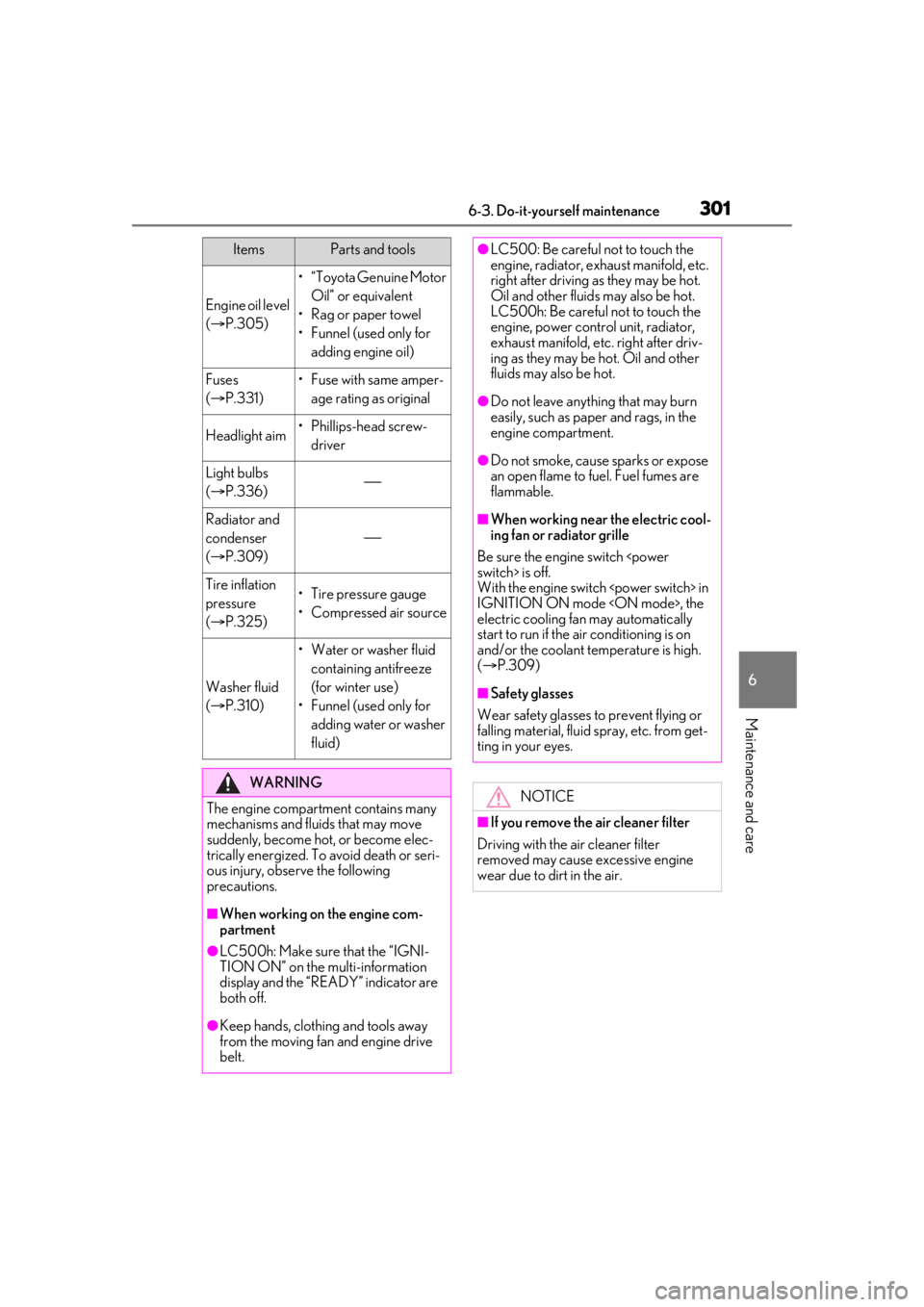
3016-3. Do-it-yourself maintenance
6
Maintenance and care
Engine oil level
( P.305)
• “Toyota Genuine Motor
Oil” or equivalent
• Rag or paper towel
• Funnel (used only for adding engine oil)
Fuses
( P.331)•Fuse with same amper-
age rating as original
Headlight aim• Phillips-head screw-driver
Light bulbs
( P.336)
Radiator and
condenser
( P.309)
Tire inflation
pressure
( P.325)• Tire pressure gauge
• Compressed air source
Washer fluid
( P.310)
• Water or washer fluid
containing antifreeze
(for winter use)
• Funnel (used only for adding water or washer
fluid)
WARNING
The engine compartment contains many
mechanisms and fluids that may move
suddenly, become hot, or become elec-
trically energized. To avoid death or seri-
ous injury, observe the following
precautions.
■When working on the engine com-
partment
●LC500h: Make sure that the “IGNI-
TION ON” on the multi-information
display and the “READY” indicator are
both off.
●Keep hands, clothi ng and tools away
from the moving fan and engine drive
belt.
ItemsParts and tools●LC500: Be careful not to touch the
engine, radiator, exhaust manifold, etc.
right after driving as they may be hot.
Oil and other fluids may also be hot.
LC500h: Be careful not to touch the
engine, power control unit, radiator,
exhaust manifold, etc. right after driv-
ing as they may be hot. Oil and other
fluids may also be hot.
●Do not leave anything that may burn
easily, such as paper and rags, in the
engine compartment.
●Do not smoke, cause sparks or expose
an open flame to fuel. Fuel fumes are
flammable.
■When working near the electric cool-
ing fan or radiator grille
Be sure the engine switch
With the engine switch
IGNITION ON mode
electric cooling fan may automatically
start to run if the air conditioning is on
and/or the coolant temperature is high.
( P.309)
■Safety glasses
Wear safety glasses to prevent flying or
falling material, fluid spray, etc. from get-
ting in your eyes.
NOTICE
■If you remove the air cleaner filter
Driving with the air cleaner filter
removed may cause excessive engine
wear due to dirt in the air.
Page 314 of 448
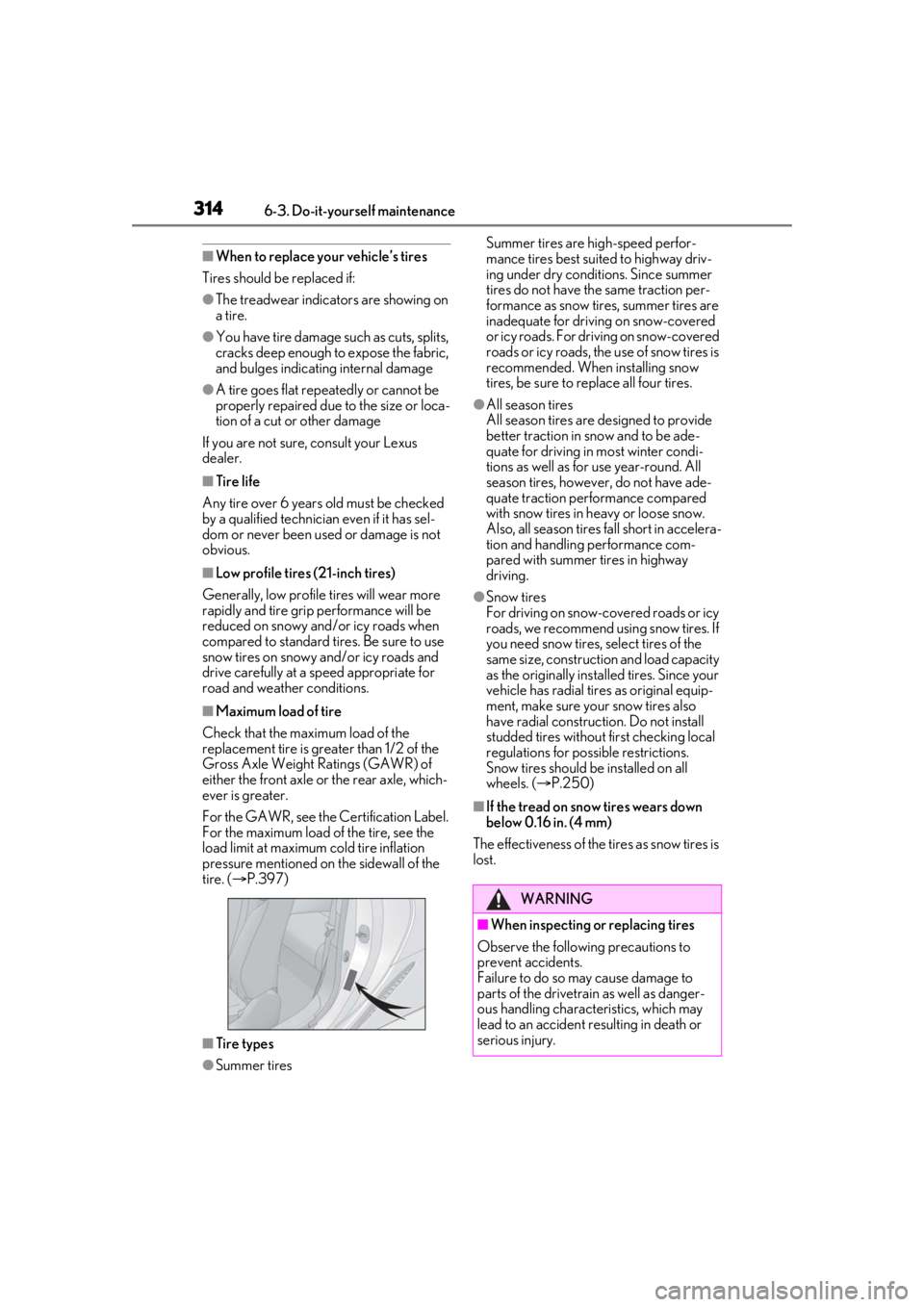
3146-3. Do-it-yourself maintenance
■When to replace your vehicle’s tires
Tires should be replaced if:
●The treadwear indicators are showing on
a tire.
●You have tire damage such as cuts, splits,
cracks deep enough to expose the fabric,
and bulges indicating internal damage
●A tire goes flat repeatedly or cannot be
properly repaired due to the size or loca-
tion of a cut or other damage
If you are not sure, consult your Lexus
dealer.
■Tire life
Any tire over 6 years old must be checked
by a qualified technician even if it has sel-
dom or never been used or damage is not
obvious.
■Low profile tires (21-inch tires)
Generally, low profile tires will wear more
rapidly and tire grip performance will be
reduced on snowy and/or icy roads when
compared to standard ti res. Be sure to use
snow tires on snowy and/or icy roads and
drive carefully at a speed appropriate for
road and weather conditions.
■Maximum load of tire
Check that the maximum load of the
replacement tire is greater than 1/2 of the
Gross Axle Weight Ratings (GAWR) of
either the front axle or the rear axle, which-
ever is greater.
For the GAWR, see the Certification Label.
For the maximum load of the tire, see the
load limit at maximum cold tire inflation
pressure mentioned on the sidewall of the
tire. ( P.397)
■Tire types
●Summer tires Summer tires are high-speed perfor-
mance tires best suited to highway driv-
ing under dry conditions. Since summer
tires do not have the same traction per-
formance as snow tires, summer tires are
inadequate for driving on snow-covered
or icy roads. For driving on snow-covered
roads or icy roads, the use of snow tires is
recommended. When installing snow
tires, be sure to replace all four tires.
●All season tires
All season tires are designed to provide
better traction in
snow and to be ade-
quate for driving in most winter condi-
tions as well as for use year-round. All
season tires, howeve r, do not have ade-
quate traction performance compared
with snow tires in heavy or loose snow.
Also, all season tires fall short in accelera-
tion and handling performance com-
pared with summer tires in highway
driving.
●Snow tires
For driving on snow-covered roads or icy
roads, we recommend us ing snow tires. If
you need snow tires, select tires of the
same size, construction and load capacity
as the originally installed tires. Since your
vehicle has radial tires as original equip-
ment, make sure your snow tires also
have radial construction. Do not install
studded tires without first checking local
regulations for possible restrictions.
Snow tires should be installed on all
wheels. ( P.250)
■If the tread on snow tires wears down
below 0.16 in. (4 mm)
The effectiveness of the tires as snow tires is
lost.
WARNING
■When inspecting or replacing tires
Observe the following precautions to
prevent accidents.
Failure to do so may cause damage to
parts of the drivetrain as well as danger-
ous handling characteristics, which may
lead to an accident resulting in death or
serious injury.